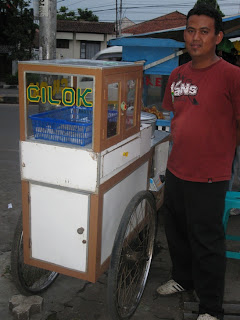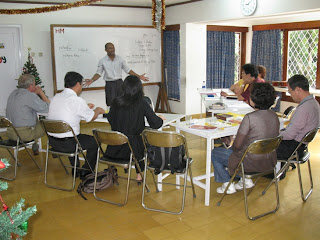Pedagang kaki-lima translates to "five-legged seller" and is a common site in Indonesia. So how do they get this name,? you may ask. Take a look at the picture below.
Many carts like this can be found being pushed around Bandung and cities all over Indonesia. Yes, these sellers are in good shape as I would guess some of them travel miles in a day! They also sell, cook, and often times prepare the food all from their cart! That takes some skill that's often learned over years. Many of these men have also developed a community or at least friendships with one another, especially if they tend to gather in one place.
I frequently visit a group of "five-legged sellers" that gather and sell their food in front of a local store. This group includes the man with the blue hat on the left selling a dish that mixes potatoes, cabbage, tofu, and maybe a couple other foods with a sauce on top. The men pictured below, along with a few others that frequently stop at this location, are also there.
 |
| Cilok is kind of like a small meat ball with a specific sauce,only sold in small bags, like a snack |
 |
| This seller sells a fried dough of sorts that is generally plain testing, so the sauce that accompanies it is almost certain. |
First the food must be prepared, thus most all carts are equipped with some a propane bottle for heating a frying pan or creating a kind of steaming machine to cook and keep the food warm. Then its waiting time, which seems to consume most of the day for these sellers or pushing their cart along to the next spot.
Once someone comes along and places an order, then its time to bag up the food for take away or to serve it up in a plate to eat on the spot. If eaten on the spot, then the sellers also must provide the eating utensils and some water and soap for cleaning afterwards.







